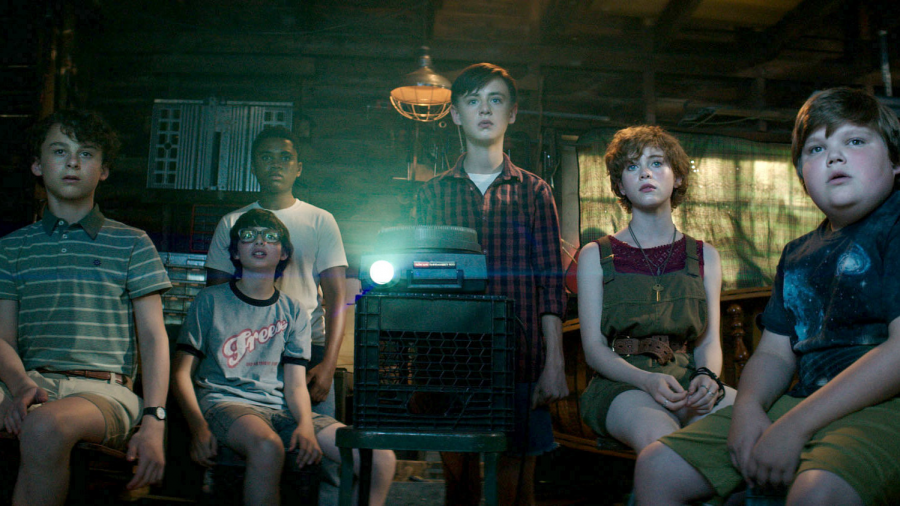Exploring the Adolescent Fear of ‘IT’
October 20, 2021
Missing children. A sleepy town. A group of pre-teen misfits. And one very creepy clown.
Andy Muschietti’s “IT” gained popularity when it first hit the silver screen back in 2017. Receiving both critical and audience success, it would go on to be one of the highest grossing R-Rated films of all time. However, upon revisiting it, did it deserve all the popularity? Or was it a bunch of clownish hyperbole?
The film follows the Loser’s Club, a group of misfits in the town of Derry, Maine (because Stephen King sure does love Maine!) After the disappearance of several local children, the Losers unite to face the evil entity that has taken them, a shape-shifting monster that takes the forms of their greatest fears.
Getting the obvious out of the way, Bill Skarsgård absolutely shines as this new version of the terrifying Pennywise the Clown.
The role was made famous by Tim Curry in the original 1990 miniseries. However, here Skarsgård was able to bring his own original energy and mannerisms to the table, in a way that felt creepily fresh.
He brought this charismatic and manic magnetism to the performance, creating a character, whose unpredictability you both dreaded and anticipated.
Both terrifying and even a bit darkly comedic, Skarsgård really made this performance his own. Viewers immediately get the sense that there is something otherworldly about this killer clown from outer space.
However, the real heart of the movie is the child actors that brought the Losers Club to life. Jaeden Martell, Finn Wolfhard, Sophia Lillis, Jack Dylan Grazer, Chosen Jacobs, Jeremy Ray Taylor, and Wyatt Olef star as outcasts Bill, Richie, Beverly, Eddie, Mike, Ben and Stanley respectively.
These kids brought an authenticity and camaraderie that few films can boast, especially in relation to child-acting. Their strong acting helped to ground both their dialogue and decision making.
As cliche as it might sound, the kids felt like real kids, with all the raunchy banter and wise-cracking that comes with the territory. The film is by no means a “coming of age” story.
Rather, seeing these young kids come to terms with their own mortality and trying to tackle the pressures of growing was pretty inspiring to watch.
Their common status as misfits draw them closer together; their friendship is one of struggle, but also support.
For example, Bill is a stutter, who is having to battle the grief of his brother, Georgie, disappearing. Eddie is a hypochondriac with an overbearing mother. Ben is an intelligent, yet shy new kid in town, who is bullied for his weight.
Richie is a jokester with a loud mouth that gets him into trouble. Stan is the nervous son of a Jewish rabbi. Beverly faces the abuse from her creepy father. And Mike is a home-schooler bullied for his race.
And while the film doesn’t completely flesh out everyone’s character development (Mike especially suffers in that department), the kids still remained believable and likeable enough that you both relate and root for them.
The dangers these kids face are often just as, if not more, scary than the threat of Pennywise. By grounding the film in reality, the film is able to stay believable.
Similarly, there is a palpable sense of danger that is felt through the course of the runtime. Sure, Muschietti does make time to give the audience room to breathe. But the dangers lurking in the shadows of Derry are present throughout the whole film.
Whether it is through the use of clever camera “blocking” (the use of staging an actor or object about the camera,) creature make-up effects, or composer Benjamin Wallfisch’s haunting score, the film is always doing something to keep the audience on their toes.
Sadly, however, oftentimes the film falls into the trap of indulging a bit too often on jump scares, a tactic many modern horror films often over rely on to grab a reaction from their audience.
Muschietti thankfully doesn’t overdo it, relying more on creepy atmosphere and violence to make the scares more threatening.
All-in-all, this accumulates in a movie that has enough scares and sentimentality to keep audiences coming back for more.
Like many of Stephen King’s best stories, its strong cast of characters, poignant themes and of course, scary monsters, have enough of a punch to keep audiences coming back for more! While it is far from a perfect film, its timeless relevancy of maturity is able to pin an undercurrent in all of us. Something familiar and thoughtful. Something we’ve all had to face: fear.
And while fear can take many forms, courage and friendship can too.




